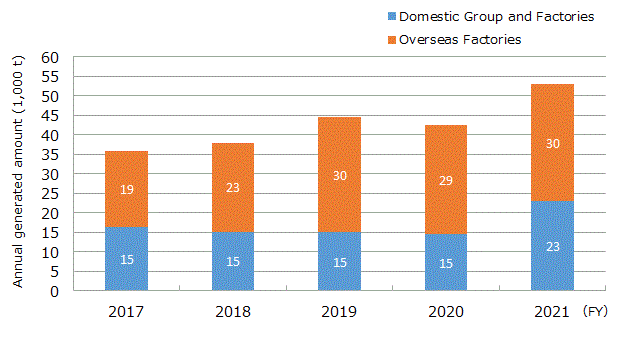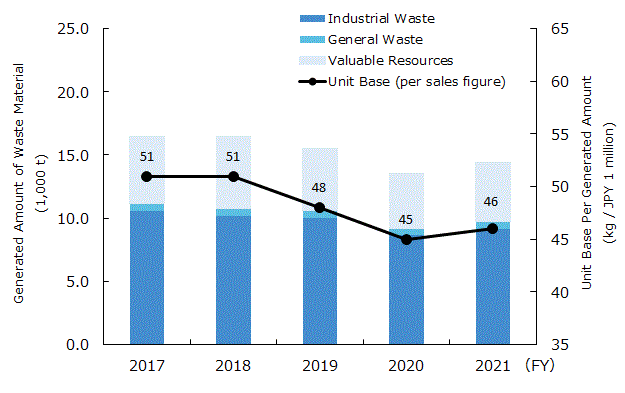The Environment
Effluent and waste
KPI
Responsible Departments
Stance and Target
Review of FY 2021 Activities
Introduction of Initiatives
Issues and Future Improvement Measures
KPI
Move the screen to the left or right to see the table information
| Item | FY 2020 results | FY 2021 results |
|---|---|---|
| Achievement of total zero-emissions |
Landfill rate 1.40% Percentage of bases achieving target 80.0% |
Landfill rate 1.63% Percentage of bases achieving target 84.4% |
| Water quality and total wastewater emissions by type of discharge | Surface water 4,712,000 m3 Groundwater 0.0 m3 Sewerage 1,198,000 m3 Others 407,000 m3 |
Surface water 4,838,000 m3 Groundwater 0.0 m3 Sewerage 1,226,000 m3 Others 398,000 m3 |
| Total number of serious leaks and amount of wastewater leaked | None | None |
| Number of incidents of non-compliance with water quality/quantity permits, standards and regulations | None | None |
| Total quantity of hazardous waste transported, imported or processed, and percentage of waste that was transported internationally | NA | NA |
| Waterways and connected habitats affected by wastewater discharge — locations, size, conservation status, and value of biodiversity | NA | NA |
Responsible Departments
Each business location
Stance and Target
Why is “Effluents and Waste” a critical issue to be addressed?
Explanation of the reason and background
We believe that minimizing the impact of our business activities in Japan and overseas on the environment will lead to sustainable operations. Accordingly, we believe that it is important for effluents and waste to be minimized as much as possible in a form with a low environmental impact.
Vision (attainment goal) / target
Mid-term targets are set for water use in Japan and overseas.
Based on these targets, and after confirming water risks and the status of wastewater, we will improve recycled water use and ultimately aim for a closed system.
We will work to achieve a reduction of 1% in waste materials per unit of waste, and aim for the attainment and maintenance of 100% recycling*1. We will then aim to achieve total zero-emissions*2 at all our production bases.
Specially managed industrial wastes such as PCB, asbestos, chlorofluorocarbons, and mercury, etc., will be appropriately processed in accordance with relevant laws and regulations.
Based on these targets, and after confirming water risks and the status of wastewater, we will improve recycled water use and ultimately aim for a closed system.
We will work to achieve a reduction of 1% in waste materials per unit of waste, and aim for the attainment and maintenance of 100% recycling*1. We will then aim to achieve total zero-emissions*2 at all our production bases.
Specially managed industrial wastes such as PCB, asbestos, chlorofluorocarbons, and mercury, etc., will be appropriately processed in accordance with relevant laws and regulations.
- 1 100% recycling: Achieve zero final disposal (= direct landfilled amount + incineration disposal amount resulting in ineffective use)
- 2 Total zero-emissions: Make the direct landfilled amount zero.
Measures for vision achievement
- We will introduce water recycling facilities, increase recycled water use, and reduce the volume of water discharge.
- Even in the case of business locations that are legally entitled to have waste disposed of in landfill sites, we will look for and select industrial waste disposal contractors that do not conduct landfilling, and contract with them to undertake recycling processing.
- The processing of PCB-containing devices will be conducted within the deadline specified by law.
Review of FY 2021 Activities
At overseas production bases in areas with high water risks (Thailand and India), closed systems have been introduced at the time of plant construction, and there is minimal water uptake and no water discharge.
Effluent volume was 6,463,000 m3 (up 2.3% from the previous year). Domestic effluent increased 2.4% over the previous year due in part to increased production, although leakage countermeasures were also taken.
Overseas wastewater discharged increased 12.6% over the previous year, due in part to the expansion of the scope of calculation, plant expansion, and increased production.
Effluent volume was 6,463,000 m3 (up 2.3% from the previous year). Domestic effluent increased 2.4% over the previous year due in part to increased production, although leakage countermeasures were also taken.
Overseas wastewater discharged increased 12.6% over the previous year, due in part to the expansion of the scope of calculation, plant expansion, and increased production.
Non-compliance with water quality/quantity permits, standards, and regulations
Move the screen to the left or right to see the table information
| FY 2020 | FY 2021 | |
|---|---|---|
| Number of non-compliance incidents | 0 | 0 |
| Penalties (financials and/or operational) | None | None |
| Fines | None | None |
| Guidance/Enforcement orders | None | None |
Amount of waste material generated at Group companies in Japan and overseas
In FY2021, the total waste disposal volume for the entire domestic and overseas group increased by 8.9% from the previous year to 52,558 tons, due to an expansion of the scope of calculation, an increase in the number of plants and production volume, and partial revision of the calculation method.
In FY 2019, 875 tons (1.66%) and in FY 2020, 677 tons (1.40%) were landfilled.
In FY2021, we increased to 857 tons (1.63%) due to increased production and expansion.
We will continue our efforts to achieve complete zero emissions and recycling treatment.
In FY 2019, 875 tons (1.66%) and in FY 2020, 677 tons (1.40%) were landfilled.
In FY2021, we increased to 857 tons (1.63%) due to increased production and expansion.
We will continue our efforts to achieve complete zero emissions and recycling treatment.

PCB waste storage and management
Used PCB-containing devices are properly stored and processed according to relevant laws and regulations. During fiscal year 2021, 18.0 tons of PCB-containing devices were processed.
This includes the processing of stabilizers registered and stored since FY2016.
Partial processing was implemented in fiscal year 2021.
Additionally, we will proceed with implementing proper processing of PCB-containing devices in use.
This includes the processing of stabilizers registered and stored since FY2016.
Partial processing was implemented in fiscal year 2021.
Additionally, we will proceed with implementing proper processing of PCB-containing devices in use.
Introduction of Initiatives
At the Onomichi Plant, we have improved and strengthened water filtration capabilities, worked to stabilize water quality, and succeeded in significantly improving the period of possible repeated use.
Amount of waste material generated at production bases in Japan
The amount of waste generated in FY2021 was 14,389 tons, an increase of 6.3% from the previous year, and the waste generation per unit of sales (per net sales) also worsened by 9.5% from the previous year.
This was due to an increase in production volume and higher treatment costs.
This was due to an increase in production volume and higher treatment costs.

The processing flow for waste materials at production bases in Japan during fiscal year 2021 was as follows.

1) Excluding general industrial waste
2) Consumer paper manufacturing waste, tree planting material, various consumer waste
2) Consumer paper manufacturing waste, tree planting material, various consumer waste
In order to prevent improper disposal such as illegal dumping, local audits of all our processing contractors are conducted every year. In fiscal 2021, although under COVID-19, we conducted 87 audits in Japan, including Group companies, and 94 audits at overseas factories to confirm that waste was properly disposed of.
Issues and Future
Improvement Measures
- Selection of overseas production bases of industrial waste disposal contractors that don’t conduct landfilling
- Development of low-water-use facilities, and review of and investment in closed systems
- Formulation of disposal plans for devices that are currently in use which contain low concentrations of PCB
- Consider increasing the effective recycling value by increasing the ratio of valuables from industrial waste


